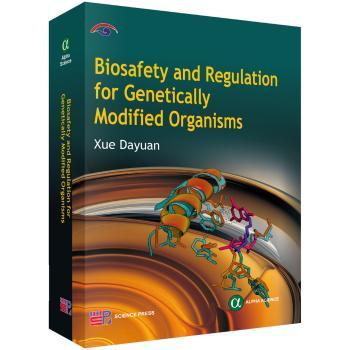内容简介
《转基因生物与管理》主要由三部分组成。部分介绍了转基因技术的生物学基础括基因工程的原理、转基因技术的方法与发展、转基因生物及其产品对环境和健康的潜在风险,以及风险评估和风险管理的方法与内容;部分分析了转基因生物管理的政策、法规与制度体系括靠前公约、部分国家的立法与管理经验,以及中国的相关法规制度与管理实践;第三部分阐述了转基因生物及其产品的社会-经济影响括转基因产品的标识、对靠前贸易的影响、损害赔偿与补救、事故应急管理,以及公众意识与参与等。书中许多内容是基于作者多年从事转基因生物的研究工作和参加联合国相关公约靠前谈判的经历,因此具有比较明确的观点。 《转基因生物与管理》可作为高等院校相关专业本科生和研究生学因生物课程的教材,也可作为相关管理人员的培训教材和科研人员的参考书目。
目录
Contentr>Introduction 1
Chapter 1 Molecular Basis of Geic Engineering 18
1.1 The concept and structure of gene 18
1.2 DNA replication 20
1.3 DNA transcription and its regulation 23
1.4 Post-transcription processing and regulation of RNA 24
1.5 Protein expression and its regulation 28
1.6 Restriction endonuclease 30
Chapter 2 Principles and Applications of Geic Engineering 32
2.1 important events in the history of the development of recombination DNA 32
2.2 Isolation of target genes 34
2.3 Recombinant 35
2.4 Vectors for geic engineering 37
2.5 Plant transformation methods 39
2.6 Methods of developing transgenic animals 42
2.7 General process of GMO research and development 44
Chapter 3 Development of Transgenic Biotechnology 45
3.1 Development of transgenic plants 45
3.2 Studies of transgenic animals 49
3.3 The researches on geically modified microbes 63
3.4 Geic engineering vaccine 70
Chapter 4 Potential Health Risks from Geically Modified Organisms 76
4.1 Commercial production status of geically modified food 77
4.2 The exposure of DNA 79
4.3 Potential risks of GM food to health 82
4.4 The scheme of risk assessment of geically modified food 87
Chapter 5 The Potential Ecological Risk of Geically Modified Organisms 90
5.1 Impact of GMOs on the ecological environment 90
5.2 Horizontal gene flow – biosafety concern for recombinant DNA 95
5.3 Vertical gene flow - theoretical foundation of alien gene escape 98
Chapter 6 Risk Assessment of GMO: Methods and Cases 110
6.1 Principle and methods of geically modified organisms risk assessment 110
6.2 Risk assessment of the geically modified crops 113
6.3 Risk assessment of the geically modified food crops 121
6.4 Risk assessment of the geically modified forests 126
6.5 Risk assessment of the geically modified microorganism 128
Chapter 7 Risk Management for GMOs 129
7.1 The defi nition, goals and requirements of risk management 129
7.2 The theoretic foundation on GMOs risk management—Scientifi c Uncertainty 130
7.3 Principle of risk management——Precautionary principle 133
7.4 Practice of GMOs management——take EU as an example 139
Chapter 8 Detection and Monitoring of Transgenes 143
8.1 The signifi cance and necessity of detection and monitoring of transgenes 143
8.2 Detective methods of transgenes 144
8.3 Immunology analysis of the proteins in GMOs 153
8.4 The detection method of transgenic microorganisms 155
8.5 The uniform standards of the GMO detection experiment 156
8.6 Environment monitoring of GMOs 158
Chapter 9 Biosafety International Law: Cartagena Protocol on Biosafety 165
9.1 The background of the Protocol 166
9.2 The basic principles of biosafety protocol 169
9.3 Main contents of biosafety protocol 173
9.4 The negotiation progress after Biosafety Protocol 181
Chapter 10 Biosafety Legislations in Some Countries 192
10.1 Biosafety legislation in European Union 192
10.2 Biosafety legislation in the United States 198
10.3 Biosafety legislation in Japan 201
10.4 Biosafety legislation in India 206
10.5 Biosafety legislation in Brazil 211
10.6 Biosafety legislation in Australia 214
Chapter 11 framework of China’s Biosafety Policies, Regulations and System 217
11.1 Policy framework of biosafety in China 217
11.2 Current laws and regulations on GMO biosafety in China 224
11.3 Management system and implementation procedures of GMOs 244
Chapter 12 Tranoundary Movements and Labeling of Living Modified Organisms (LMOs) 254
12.1 Main contents of tranoundary movements of LMOs 255
12.2 Negotiation process of tranoundary movements of LMOs in the Protocol 257
12.3 Labeling requirements of LMOs and international tendency 264
12.4 Labeling of GMO in China 271
Chapter 13 Damage Liability and Redress in Biosafety Law 279
13.1 Principles and mechanisms of international environmental damages legislation 279
13.2 International negotiations on biosafety damage liability and redress 281
13.3 Proposed principles of international biosafety damages legislation 286
13.4 Proposed mechanisms in international biosafety damages legislation 288
13.5 Biosafety damages legislation of some countries and regions 291
13.6 China’s legislation on biosafety damages and its impacts 293
Chapter 14 Socio-Economic Impacts of GMOs 298
14.1 Attention by the international society to the socio-economic impacts of GM crops 298
14.2 Types of social—economic impact of GMOs 304
14.3 Relationship between Biosafety Protocol and TWO 311
14.4 Pole Impact of Safety Management on the International Trade 317
Chapter 15 Emergency Management for Biosafety 329
15.1 Theoretical analysis 329
15.2 International law and the management of GMOs 331
15.3 National laws 335
15.4 Emergency management of GMOs safety in China 338<




 VIP会员
VIP会员